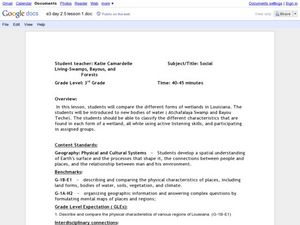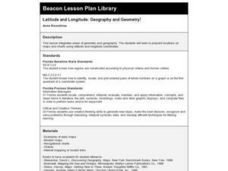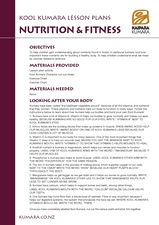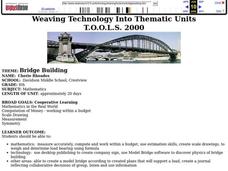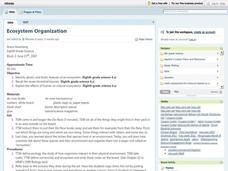Curated OER
Class Conservation Corps (CCC)
Students investigate how the loss of soil, a valuable natural resource, affects their lives through loss of productive land to grow food, loss of coastal land mass, and poor water quality from runoff. They design a project to keep soil...
Curated OER
Ticket to Ride
Learners research a place they would like to visit. They write a report about that location that includes a map, the climate and other features that explain their desire to visit.
Curated OER
Marine Animals on the Move
Students complete a project based on collecting satellite data aimed at finding connections between organisms and the environment. They create a final project working with a partner to share with the class.
Curated OER
Exploring Explorers
Ninth graders illustrate the routes taken by different explorers on a world map. They explain the need for the different exploration voyages. Students explore the web for information that may contain different points of view or...
Curated OER
Desert Postcards
Students research characteristics of deserts. They present their findings in small groups to the class. Students utilize information learned about desert biomes, geography of the route of the Niger, and expeditions in their writing.
Curated OER
Where the Red Fern Grows: A 4th Grade Literary Focus Unit
Fourth graders explore the human and animal connection along with the idea that death is a part of the life cycle. They read "Where the Red Fern Grows." Students examine the feelings and emotions surrounding death and they discover the...
Curated OER
Living Swamps, Bayous and Forests
Third graders explore interesting environments by exploring Louisiana. In this wetland lesson, 3rd graders utilize the web to research the State of Louisiana, the bayous in the area, and the Gulf of Mexico. Students write a journal entry...
Curated OER
Latitude and Longitude: Geography and Geometry!
Second graders use latitude and longitude coordinates to pinpoint an exact location on the map. In this geography instructional activity, 2nd graders utilize handouts from the Maritime Museum in order to gain practice in finding...
Curated OER
Introduction to AP Chemistry
Students are introduced to concepts in an AP Chemistry class. They work together to complete experiments on different materials. They discuss the results of the experiments.
Curated OER
Journey to Japan: An Elementary Geography Standards-Based Unit on Japan
Second graders compare and contrast Japanese customs and culture to those of Americans through research in this year long study. They determine the basic needs of all people in spite of cultural differences.
Curated OER
Nutrition and Fitness
Sixth graders investigate the food guide pyramid. They conduct Internet research, and plan a three day nutritional menu appropriate for teenagers. Students include three meals per day and a snack for each day on their menu, and...
Curated OER
Photography
Students practice the basic operation of a point and shoot camera while taking a variety of photographs. Included in this lesson are various activities that aid the student in becoming familiar with camera terminology and usage. Students...
Curated OER
Let's Find Out About Money
First graders investigate the uses and development of money as part of the study of finance. They focus upon the recognition of different coins and identify the value of each. Then students solve problems involving money and coins.
Curated OER
Intro to 2D Motion
Students study straight line motion and motion due to gravity. In this motion lesson students analyze several experiments.
Curated OER
Bridge Building
Eighth graders will create model drawings of bridges and integrate technology into the process of creating a visual representation. Technology is used in the industry of design and architecture. This lesson plan helps to build real life...
Curated OER
Ecosystem Organization
Eighth graders engage in a lesson about ecosystems with the intention of looking at how it is organized. They cover the biotic and abiotic factors of an ecosystem while looking at the seven types of terrestrial biomes. Students write...
Curated OER
It's All in the Translation
Students compare and contrast translations of Greek literature. In this dramatic literature lesson, students read and perform passages from four different translations of Euripides's Hecuba. Students discuss how the translations...
Curated OER
Identifying Clouds
Eighth graders research and present to the class information about cloud categories. They observe clouds and describe the characteristics of their cloud observations. They take a cloud identification quiz.
Curated OER
Earth Science: The Sun-Earth Relationship
Students examine the sun's impact on the Earth. They read online articles, explore various websites, and answer questions using information found on the Internet.
Curated OER
Changes in the Community
Third graders examine and describe a series of primary sources (mostly photographs) to observe and analyze changes over time. The focus is on the local community. The local community might be a city, township, county or surrounding area.
Curated OER
What Is That Bubblin¿¿¿ In My Back Yard?
Students create a map plotting local sites the Environmental Protection Agency has on its EPA Regulated Sites list. They discuss the need for citizens to, at a minimum, be aware of potential pollution hazards in their community.
Curated OER
The Historical Geography of Mesopotamia
Students show how the geography of the Mesopotamia region has impacted the beginnings of civilization. They show how this area has long been the site of the rise and fall of great empires, and how the geography of this region has a lot...
Curated OER
Across Five Aprils
Eighth graders are introduced to the novel "Across Five Aprils" written by Irene Hunt. They become familiar with the people, places, and events referenced in the story and comprehend the story of the Civil War. Students are given a...
Curated OER
Anty-Bodies
Learners compare and contrast likenesses and differences to others by creating a life-size picture of themselves. In this character building lesson, students dictate a sentence about comments on sharing and display them with their...








